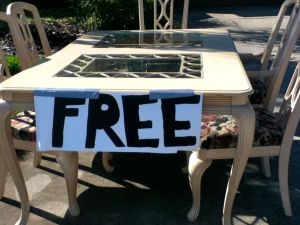The dining table is an important piece of furniture in a family. It’s where we all meet to share conversation, enjoy meals, gather for big holidays, celebrate birthdays, etc. The dining table is the root of some of our fondest family memories. “Remember when Uncle Frank told that joke during dinner and Uncle Ralph laughed so hard coffee shot out of his nose?” “Remember Marcie’s first birthday party where she tried to eat her birthday candles?”

For a home learning family, the dining table also serves as a daily meeting spot around learning. Instructional video creations, science projects, paper sculptures, model rockets, and writing projects took shape around the dining table. So, it was a big deal when our family decided to upgrade the table and give the old table away. Everyone in the family had an unspoken connection to the table and no one wanted to part with it at first. However, it wasn’t in great shape and a newer, bigger, stronger table presented itself for free.
We decided to give our old table away for free so as to benefit someone else. We cleaned the table, carefully carried it out to the curb, put a nice big “free” sign on it, and looked upon it with great memories. Our youngster had an especially difficult time with the idea of giving away such a central part of his young life until we turned the giving into a life lesson.
Lessons Learned
Empathy – Giving away something meaningful to benefit another is a powerful lesson in empathy. The table, instead of tossed in the trash, has a new lease on life with the chance for another family to build memories and photos around it. Perhaps the new owners couldn’t afford a table before, and this new table will allow them to sit together at dinner for the first time.
Reuse – Reusing used furniture items can reduce the demand for new item purchases. A greener, more sustainable model for living in harmony with our environment calls for better stewardship of our resources, including trees and garbage dumps.
Perspective – “Stuff”, no matter how symbolic it is in our families, is just stuff. It cannot replace or measure up to the human connections we have with each other. It should never be placed on so high a pedestal that it interferes with what is truly important. Understand the role that stuff plays in our lives, but don’t let it play the starring role. The starring role in our lives belongs to our family, friends, neighbors, community, country, and global connections. What better way to strengthen this connection than through giving?














